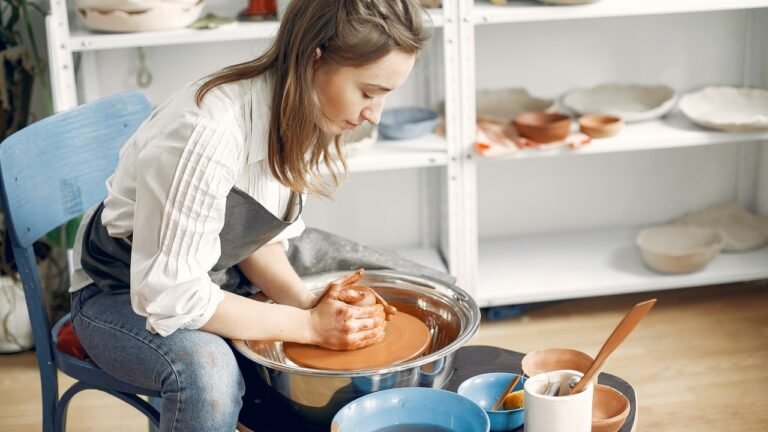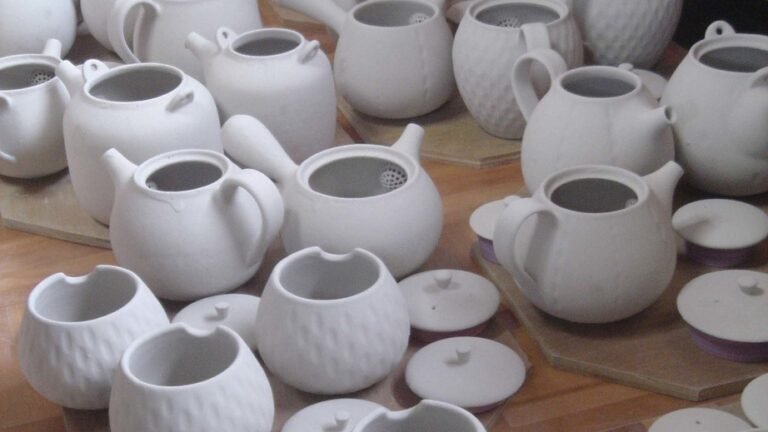The Underglaze Flakes Off After Firing: What Are The Solutions?
When you are glazing, you have to be aware of various conditions. Otherwise, many issues will arise, like peeling or flaking. What causes the glaze to flake off? Can I prevent the underglaze from flaking off?
Thick underglaze layers are rigid and solid, prone to cracking, peeling, and flaking. To get an opaque finish, apply 2-3 thin layers of underglaze rather than one or two thick ones. Underglaze separates from the clay if clay and underglaze shrink at different rates.
Underglaze flaking is more likely to happen on curved ware or edges. Pot edges dry out faster due to high air exposure. Some parts of the pottery with underglaze ahead of drying are under more tension.
How Can I Keep The Underglaze On Greenware From Flaking?
(1) Many Thin Layers Are Better Than One Thick Layer
Upon drying, underglaze behaves the same way as other water-based paints. A thick underglaze layer increases the likelihood of cracking. Underglaze manufacturers recommend applying 2-3 thin layers for a translucent finish.
Several thin layers are ideal for achieving a gradual color change. Let each application dry before applying another. Adding another coat to a wet underglaze will lift the old one off.
(2) Inspect The Underglaze For The Ideal Consistency
Make sure the underglaze is not too thick or too thin. Underglaze that is too thin will make it hard to build up color. You can find the correct consistency by applying it first to a test tile. Check whether it produces enough coverage, color, and opacity.
(3) Match The Shrinking Rates By Adding Clay To Your Underglaze
You can mix the underglaze with a bit of smooth clay slip. It will help the underglaze shrink at the same rate as the clay. Using the same clay body as the clay slip will yield the most effective results.
(4) Make Sure The Drying Process Is Proceeding At An Even Pace
Maintain an even drying rate throughout the pottery. Certain areas of the pot, such as handles and fine details, dry faster due to high air exposure. You can slow down the evaporation process by covering the pottery.
(5) Pick The Middle Clay (Leather-Hard) Instead Of The Extremes
Applying underglaze to leather-hard clay will prevent extra strain on it. A wet clay needs a lot of shrinking while drying. Bone-dry clay can suck out underglaze faster due to its high absorbency. As a result, the bond between the pot and the underglaze will be less effective.
(6) An Underglaze Touch-Up May Sometimes Be Helpful
Sometimes you may be able to restore the affected area with a touch-up of underglaze. You can also apply a touch-up layer after bisque firing the pot. The underglaze is more likely to show its texture in the glaze firing if it has cracked.
Related> How to Glaze Pottery at Home? Explained for Beginners
What Are Other Possible Reasons For Underglaze Not Adhering Well To Bisque Pottery?
Glaze and underglaze do not adhere well to bisque ware with oily marks, dust, and debris. Decorate the bisque ware by wiping it with a damp sponge.
Underglaze may also flake, crack, or peel during the glazing process. A bisque fire may not always change the underglaze. It may take a glaze fire for the issue to become visible.
What Are The Best Practices For A Stable Underglaze?
Ensure that the underglaze has dried before applying the glaze. The glaze needs to be dry before starting the glaze firing.
Some underglaze colorants do not melt at lower temperatures. As a result, the underglaze can not bond with the overglaze. Melt the underglaze by firing the piece at a higher temperature.
A higher firing temperature can cause color changes in the underglaze. Mix some clear glaze in with the underglaze. It allows the underglaze and glazes to melt around at similar temperatures.
You can add Gerstley Borate to your underglaze to add some flux. It prevents the underglaze from crazing and allows it to melt at a lower temperature.
The applying method can also affect flaking, peeling, or cracking. Spraying is more convenient than dipping or brushing when applying glaze as a thin layer. Make sure the underglaze you are using is fresh and in proper condition.
What Does Underglaze Look Like When Fired?
When fired, a color applied in only one layer will appear translucent. Using only one coat of underglaze will also reveal brush strokes. When painting underglaze, use at least two layers to achieve a rich color. The more layers you apply, the more opacity you will create.
What Is The Difference Between Glaze And Underglaze?
The glaze fuses with the clay body and seals the fired clay or bisque. When added to a bisque piece, it creates a shiny glass cover. It is possible to apply underglazes to leather-hard clay before firing it.
What Is Glaze Shivering?
When the thermal expansion of the clay body is greater than that of the glaze, shivering occurs. This major glaze issue results in the fired glaze peeling off the underlying clay surface. Upon cooling, shivering can tear or break the underlying clay body. It can cause the pottery to crumble.
Can You Fire Underglaze Twice?
Glaze fire pottery twice or more if you wish. You can glaze fired-pottery several times to add textures or effects. Two bisque firings won’t harm your ceramics. For various reasons, most people bisque fire more than once. Before glazing, some do this to seal the underglaze.
Some glazes and fires may not achieve the desired results at once. To achieve the desired color and texture on your pottery, you can reglaze it.
Some decorative techniques involve many firings at lower temperatures. A simple example of this would be using China paint. Most pottery glazes need 1-3 layers.
There is also a drawback to many firings though it has no limit. The deal is with the material, not the glazing. Each firing, including bisque firings, weakens the pottery. Pottery starts to become weak and brittle after the third or fourth firing.
Conclusion:
Some underglaze product ranges may have more cracking-prone colors. Different underglaze brands use various ingredients for manufacturing. Applying it to clay will result in distinct behaviors.
The same underglaze exhibits different behaviors when applied to various clay bodies. The underglaze may crack if the brand or color does not match the clay. Experiment with many brands and clay bodies until you find the right match.






